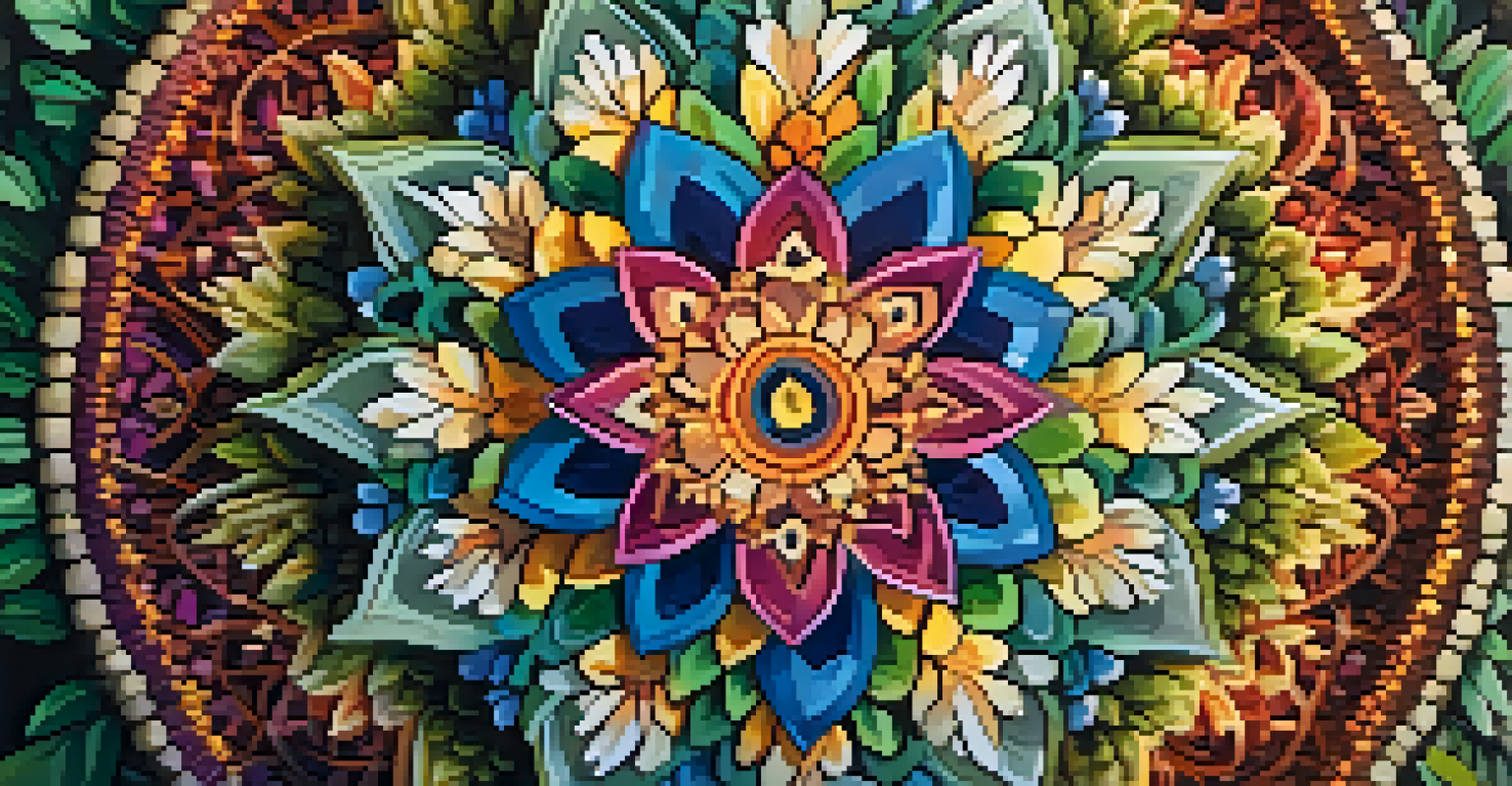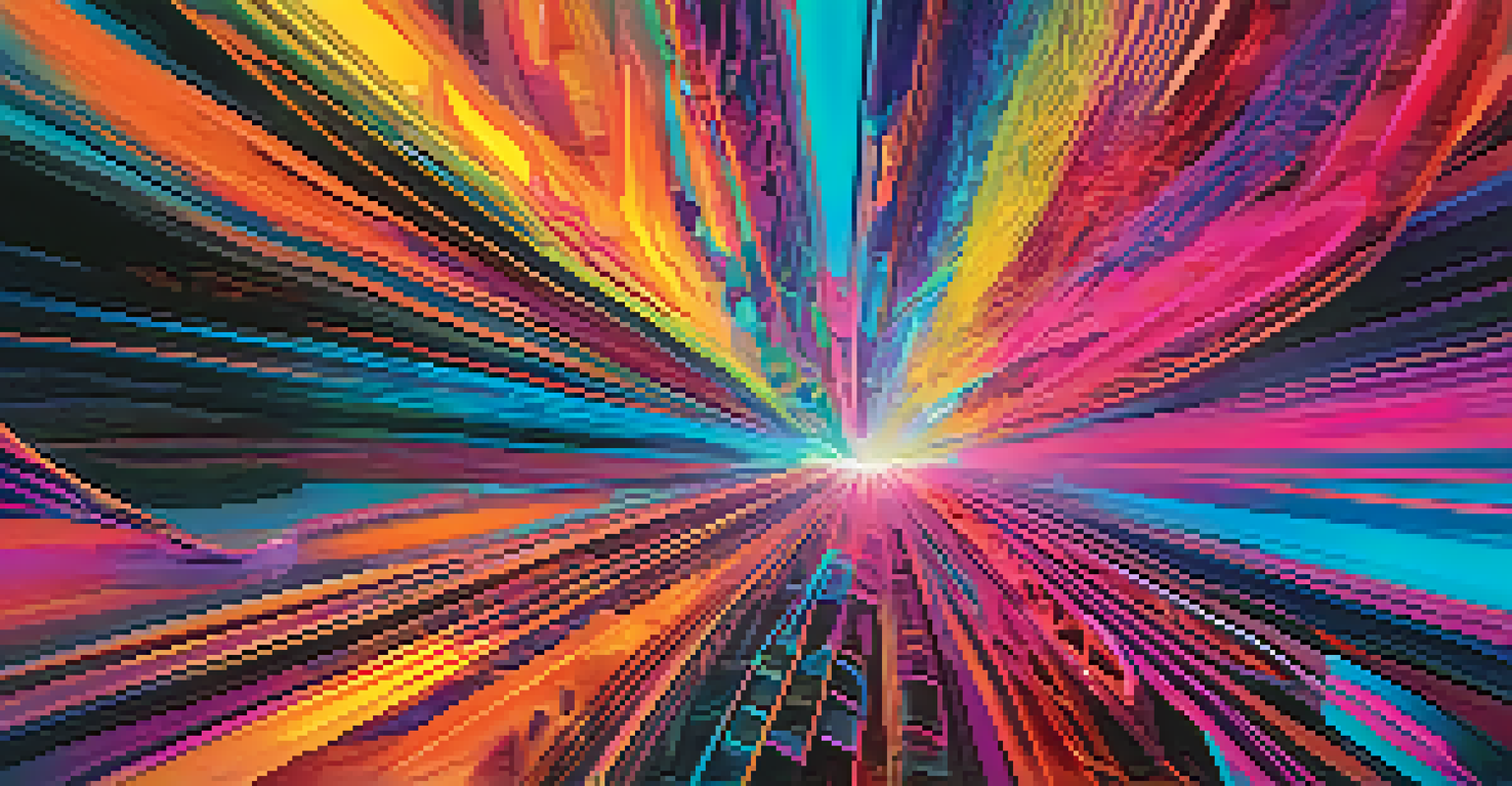The Influence of Psychedelics on Contemporary Art Movements

Understanding Psychedelics and Their Cultural Context
Psychedelics, substances that alter perception and consciousness, have fascinated humanity for centuries. From ancient rituals to modern therapeutic uses, their cultural significance is profound. They challenge our understanding of reality, pushing artists to explore new creative boundaries. In contemporary society, this exploration has sparked a resurgence of interest in these substances and their potential influence on art.
Psychedelics are a tool for enhancing creativity and accessing deeper layers of consciousness.
The 1960s counterculture saw a significant embrace of psychedelics, which played a crucial role in shaping various art movements. Artists like Andy Warhol and Peter Max drew inspiration from psychedelic experiences, infusing their work with vibrant colors and surreal imagery. This era marked a cultural shift where tapping into altered states of consciousness became a legitimate artistic pursuit, inspiring future generations of artists.
Today, as we witness a new wave of psychedelic research, artists are once again turning to these substances for inspiration. With the rise of mindfulness and mental health discussions, the dialogue around psychedelics has evolved, making it relevant in contemporary art. As artists experiment with these themes, their work often reflects deeper issues of society, identity, and consciousness.
The Surrealist Movement: A Psychedelic Precursor
Surrealism, which emerged in the early 20th century, is often viewed as a precursor to the psychedelic art movement. Artists like Salvador Dalí and Max Ernst created dreamlike images that invited viewers to question reality. Their work, infused with irrational juxtapositions and bizarre imagery, mirrors the experiences of those under the influence of psychedelics.

Surrealism sought to tap into the subconscious, a theme that resonates with the psychedelic experience. Both aim to unlock deeper truths about human existence, challenging conventional perceptions. By exploring dreams and altered states, surrealists paved the way for later artists to experiment with psychedelics as a source of inspiration.
Psychedelics Influence Artistic Movements
Throughout history, psychedelics have significantly shaped various art movements, inspiring artists to explore new creative boundaries.
In contemporary art, the influence of surrealism continues to manifest through vibrant colors and abstract forms. Artists today often blend surrealistic techniques with psychedelic elements, creating works that evoke an altered state of consciousness. This fusion invites viewers to explore their perceptions and emotions, much like the psychedelic experience itself.
Psychedelic Art in the 1960s and 1970s
The 1960s and 1970s marked a pivotal moment in the relationship between psychedelics and art. This era was characterized by a vibrant explosion of color, intricate patterns, and mind-bending visuals, largely influenced by the psychedelic experience. Artists like Victor Moscoso and Rick Griffin created iconic posters for concerts, blending graphic design with psychedelic themes.
The experience of psychedelics is a journey into the depths of the mind, revealing the interconnectedness of all beings.
These artists not only embraced the aesthetics of psychedelia but also sought to convey the transcendental experiences associated with psychedelics. Their work often featured swirling colors and optical illusions, designed to evoke a sense of altered reality. This visual language became synonymous with the counterculture movement, reflecting the desire for spiritual exploration and liberation.
The legacy of this psychedelic art movement is still evident today, as many contemporary artists draw inspiration from its bold aesthetics. The colorful and often chaotic imagery of the 60s continues to resonate, influencing genres like street art and graphic design. By revisiting these visual styles, modern artists connect with a rich history of creativity fueled by psychedelics.
The Role of Psychedelics in Modern Artistic Expression
Today, artists are increasingly exploring the therapeutic and creative potential of psychedelics. As more research highlights their benefits for mental health, many creatives are experimenting with these substances to enhance their artistic process. This shift reflects a growing acceptance of psychedelics as tools for exploration rather than mere recreational substances.
Contemporary artists like Alex Grey and Amanda Sage incorporate psychedelic themes into their work, often drawing from personal experiences with these substances. Their art not only reflects the visual aspects of psychedelia but also delves into deeper philosophical questions about consciousness and existence. This exploration often leads to captivating and thought-provoking pieces that resonate with a wide audience.
Visionary Art Reflects Psychedelic States
The visionary art movement channels psychedelic experiences, depicting themes of spirituality and interconnectedness that resonate with audiences.
Moreover, the rise of digital art and technology has allowed artists to create immersive experiences that echo the psychedelic experience. Through virtual reality and augmented reality, artists can engage viewers in ways that mimic the effects of psychedelics, opening up new avenues for artistic expression. This fusion of technology and psychedelia showcases a dynamic evolution in the art world.
Psychedelics and the Rise of Visionary Art
Visionary art is a contemporary movement that is heavily influenced by psychedelic experiences. Artists in this genre often seek to depict transcendental states, spirituality, and interconnectedness. This approach aligns closely with the experiences reported by those who use psychedelics, making visionary art a natural extension of this exploration.
Prominent visionary artists like Alex Grey and Android Jones utilize intricate details and vibrant colors to create works that feel alive and pulsating with energy. Their art often reflects a sense of cosmic interconnectedness, inviting viewers to contemplate their place in the universe. By channeling the psychedelic experience, these artists create a bridge between the viewer’s inner world and the broader cosmos.
The visionary art movement serves as a reminder of the transformative potential of psychedelics, both for the artist and the audience. By engaging with these themes, artists encourage viewers to reflect on their own spirituality and consciousness. This dialogue fosters a deeper appreciation for the role of psychedelics in shaping contemporary artistic expression.
The Intersection of Psychedelics and Digital Art
In recent years, the rise of digital art has created a unique intersection with psychedelic influences. Artists are now using technology to replicate and expand upon the visual experiences associated with psychedelics. Through digital mediums, they can create intricate, animated visuals that challenge our perceptions and transport us to alternate realities.
Digital platforms also enable artists to reach wider audiences, allowing for the sharing of psychedelic art in innovative ways. Social media and online galleries provide spaces for artists to showcase their work, making it more accessible to those interested in exploring these themes. This democratization of art has led to a resurgence of interest in psychedelic aesthetics within the digital realm.
Digital Art Merges with Psychedelia
The rise of digital art has created new opportunities for artists to replicate and expand upon psychedelic visuals, engaging wider audiences.
Moreover, the integration of virtual and augmented reality technologies allows for immersive experiences that mimic the effects of psychedelics. Artists can create environments that invite viewers to engage with their work on a deeper level. This evolution represents a fascinating blend of art, technology, and psychedelia, expanding the possibilities of artistic expression.
Psychedelics: A Tool for Artistic Healing and Exploration
As discussions around mental health become more prevalent, psychedelics are being recognized for their potential therapeutic benefits. Many artists are turning to these substances as a means of self-exploration and healing. This practice allows them to confront personal struggles and channel those experiences into their creative work.
Art can serve as a powerful outlet for expression, and when combined with psychedelics, it can lead to profound transformations. Artists often report enhanced creativity and insight during and after psychedelic experiences, which can result in groundbreaking work. This process not only benefits the artist but also resonates with audiences seeking connection and understanding.

The narrative around psychedelics is shifting, with a growing acknowledgment of their positive impact on creativity and mental health. As more artists share their journeys, we see a broader acceptance of psychedelics as tools for exploration and healing. This evolution fosters a rich dialogue within the art community, encouraging deeper connections between art, mental health, and personal growth.